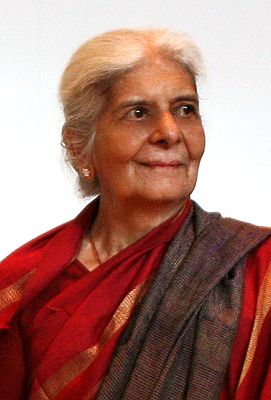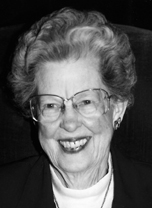A New Look at the Three Objects: Part 1, The First Object
By Robert Ellwood
The three objects of the Theosophical Society are currently written as follows:
-
To form a nucleus of the universal brotherhood of humanity without distinction of race, creed, sex, caste, or color;
-
To encourage the comparative study of religion, philosophy, and science;
-
To investigate unexplained laws of nature and the powers latent in humanity.
Universal Brotherhood
Taking the objects in order, let's begin by looking at the key words in the first, "To form a nucleus of the universal brotherhood of humanity." A nucleus, like the nucleus in a cell or the kernel of a grain of wheat or corn, is the catalyst, paradigm, or template of the whole, a bearer of the genetic molecules or DNA. It is not the whole show, but something that helps the whole be what it is meant to be. We must also note that this object says that the Society is to be "a" nucleus of the universal brotherhood---not "the" nucleus, as though the Theosophical Society presumed to be the one and only means of bringing about universal brotherhood. We have a part to play, but are not the whole show.
The word "brotherhood" is a bit more tricky. Apart from the lingering sexism in the term, there is the awkward fact that brothers do not in fact always get along. Consider Dostoyevsky's Brothers Karamazov, or the Biblical Cain and Abel, or Jacob and Esau. Anyone who has had a brother, or sister for that matter, knows about brotherly relations in a deep, visceral way. The worst hatreds, the greatest cruelties, can often be found at home. When we say "brotherhood," we are not talking about utopia.
There is, however, a difference between homefolks and outsiders. Except in the most pathological families, brothers and sisters will put aside their quarrels and stand together against outsiders in order to uphold the family name.
Moreover, brothers and sisters know things about each other. They know how the other will react on a deeper level than almost anyone else. Finally, if in the end they come to forgive each other the pain, the teasing and taunting and quarreling, even fighting, of childhood and the shame of ignoring each other in adolescence, brotherhood can be a truly beautiful and deep thing. I have seen it in my own family, among brothers and sisters who quarreled and teased as children but now as adults are the best of friends.
So in talking of brotherhood we are not really expounding easy platitudes about universal harmony and feeling good about everyone and everything. We are talking about a hard, deeply human, and deeply flawed, yet wonderful kind of relationship that can lead to no less wonderful transformations. It is a change that, like Jacob's reconciliation with his brother Esau only after he had wrestled all night with an angel and faced profound angers and anxieties, comes only with excruciatingly painful growth and maturation. It comes only after working through all sorts of stubborn feelings and problems, anger and guilt. All this must be faced and exorcised like demons---but the struggle makes the final victory into grown-up brotherhood all the more worthwhile.
Our internal relations with our brothers and sisters in the Society have not always been perfect either. But, as in any family, if our working through our differences brings us to acceptance, support, and love in spite of those differences---if it brings us in the end to rejoice in the different gifts that different people bring---that could truly be an example and catalyst for the world.
And what is the world situation in regard to brotherhood? In this day, just after the end of the cold war and to a large extent of other ideologies, the world unfortunately often seems only to be getting back to certain basics of human relations, as gritty as they sometimes are. While no vast overarching conflict of great ideologies and great powers seems to obtain today, as it did in the two world wars or in the cold war, there are plenty of people who just don't like each other, or who have such contempt of others that they are willing to commit serious crimes against them. One thinks of Ireland, Africa, the Near East, the former Yugoslavia. I don't mean to single out any one place, because it's everywhere, including in our own country. As headway seems to be made in one place, the situation becomes discouraging in another.
For the Theosophist, the situation is not easy, no more than for anyone else. We have no simple answers, only a lot of hard thinking and hard work ahead of us if we wish to contribute to the brotherhood of humanity and make our Society one nucleus of it. Yet we do have resources that can help.
Perhaps I'm an eternal optimist, but I think the situation is getting better for brotherhood overall, despite countless setbacks. It does seem better than twenty-five or fifty years ago, when we lived with the nuclear threat, with a cold war that sometimes got hot, and under the shadow of world war past and perhaps future. Although there will be numerous local conflicts in the years to come, as there are today, it is arguable there will never again be a world war like those in the first half of this century. The world is unified in numerous new subtle, almost secret, ways. One thinks of the World Wide Web, complex trade networks, quasi-governmental agencies, the United Nations, and the European Community. These may all bear their own tensions, but overall they enhance communications, cooperation, and interdependencies that militate against war on a global scale.
There may be less overt racial prejudice at home and abroad than a half century ago, and signs are emerging that humanity is making slow, almost invisible, but real progress toward global community: rising rates of intercultural friendship and marriage, pluralism everywhere of religion and culture, gradually arising common languages and norms. These are the sorts of things that will take another millennium to be fulfilled. They may be barely perceptible even in one lifetime. However, having just turned 65, I have lived long enough to remember Hitler and World War II, and the blatant racial slurs and segregation at home of another age, and I think I can say that the brotherhood picture is a bit more encouraging now than then.
A sense of slow progress like this is the picture we need if we are not to get totally discouraged. Theosophy can help us to keep faith in a gradual world advance toward brotherhood because of the Theosophical idea of spiritual evolution. According to that Theosophical concept, evolutionary progress is always being made, but very slowly, sometimes perhaps imperceptibly, and always subject to human freedom.
Let us think for a moment about what this Theosophical model of spiritual evolution means. First, we must note that not everyone is evolving at the same rate; at best we can talk only of statistical averages. This certainly is true of the world we see around us. Second, the program can be set back a long time by entities like certain early Elohim described in The Secret Doctrine who decide not to evolve. We are told, for example, in stanza 6 of the Stanzas of Dzyan that "The Sons are told to create their image. One third refuses---two obey. The curse is pronounced: They will be born in the Fourth, suffer and cause suffering. This is the First War" (1: 33).
The ancient commentary relates that "The holy youths (the gods) refused to multiply and create species after their likeness, after their kind. They are not fit forms [rupas] for us. They have to grow. They refuse to enter the chhayas [shadows or images] of their inferiors." And thus "they had to suffer for it in later births" (1: 192).
In short, it is clear that evolution is not deterministic, but entails the conscious cooperation of intelligent beings, who can always develop a bad attitude and refuse the opportunity for ultimate growth--though sometimes, as here, taking the evolutionary challenge involves apparent humiliation at the moment. Those "Sons" no doubt considered themselves too pure and too good for the realm of matter, but actually their stubbornness was a far more devastating failing than any that matter could impose. The proximate cause of our own stubbornness toward spiritual growth is often unfinished karmic business clattering after us like the chains on Marley's ghost in A Christmas Carol. It includes the addictions, angers, festering memories, and unresolved processes with other people that seem to us more pressing than the opportunity for growth to another level of being that could be ours if we could but let go of them entirely and once for all.
This letting go can be done. All the great spiritual traditions tell us that sufficient faith, as in Pure Land Buddhism or Protestant Christianity, or sufficiently fervent devotion, as in Bhakti Hinduism or Catholic Christianity, can at once burn away all sin or bad karma and enable us to start over fresh and clean without that burden. "Though your sins be as scarlet, they shall be white as snow," in the words of the Prophet Isaiah. But we are inwardly too attached to our chains, we don't really want to give them up, whatever we say, for they are at the core of our identity. Without this addiction, without this anger at this person, without this shame or guilt or psychic sore I keep gnawing at inwardly, who would I be? Would I really be I? It is not easy to give up the self I have known myself to be for so many years, however bright the alternative.
We could make the world a paradise tomorrow---we could move on to the sixth root race---if we all simultaneously willed to do so. But the unfinished business of the individual karma of many will make this unlikely. Though a few may be ready to advance in tremendous and courageous strides, as they always are, for the world as a whole to change would require that the preponderance of people make this transition all at once. That is statistically unlikely. So the world continues moving very slowly, though all we can do individually to advance ourselves also adds to the whole and speeds up the whole process by so much.
What then can we do?
First, we can strive to understand all our brothers and sisters in the intimate way members of a family can, even when we don't like the other. For family members have lived so closely together for so long, and through so many early stages of life, that they can often intuit where the other is coming from. While such intimate knowledge may at first lead to tensions, in the end it can assist the working through of difficult tensions that leads to victorious brotherhood.
Second, we can stand with others, like a family: not against others but with those who need support.
Third, we can talk in such a way as to help the world work its way back through the painful angers and memories to forgiveness and mature living together, as in a mature family. We will not expect perfection. Here as so often the "best," in the sense of a hopeless ideal, can be the enemy of the good. But we have the right to expect decent respect by everyone for all other brothers and sisters, even when it's hard.
Robert Ellwood, Professor Emeritus of the University of Southern California, is a well-known Theosophical author and speaker, currently visiting Professor at Auburn University. This article is based on a talk given at the 1998 convention of the Theosophical Society in America.


 "The world is too much with us," exclaimed the poet, and what people feel is the world is, indeed, very much with them. It hedges them in with the problems and the demands of everyday life, with changes that are unexpected and perhaps unpleasant. The difficulties begin in early childhood, possibly because parents are unsympathetic or because they do not know how to help their child. Later, the problems multiply—in school and college, in the course of a married life, with the additional pressures of practicing a profession or administering property. Life consists of meeting numerous responsibilities—the demands of a particular situation, the people with whom one becomes involved, the family and professional colleagues. Thus the world pushes each of us into involuntary actions.
"The world is too much with us," exclaimed the poet, and what people feel is the world is, indeed, very much with them. It hedges them in with the problems and the demands of everyday life, with changes that are unexpected and perhaps unpleasant. The difficulties begin in early childhood, possibly because parents are unsympathetic or because they do not know how to help their child. Later, the problems multiply—in school and college, in the course of a married life, with the additional pressures of practicing a profession or administering property. Life consists of meeting numerous responsibilities—the demands of a particular situation, the people with whom one becomes involved, the family and professional colleagues. Thus the world pushes each of us into involuntary actions. In 1975 my brother and I, 20 and 22, embarked on a pilgrimage across the eastern United States, venturing forth from our parents' New England home in the autumn. We lived on alms and walked fifteen to twenty miles daily on back country roads, heading first west, "maybe to California," but then turning south to stay ahead of the approaching winter. Our long walk thus took us out across Massachusetts and upstate New York, and then south through Pennsylvania into the hills and hollers of West Virginia and eastern Kentucky, and then down through Tennessee and finally into Alabama where we landed in early 1976 in a meditation center in Huntsville.
In 1975 my brother and I, 20 and 22, embarked on a pilgrimage across the eastern United States, venturing forth from our parents' New England home in the autumn. We lived on alms and walked fifteen to twenty miles daily on back country roads, heading first west, "maybe to California," but then turning south to stay ahead of the approaching winter. Our long walk thus took us out across Massachusetts and upstate New York, and then south through Pennsylvania into the hills and hollers of West Virginia and eastern Kentucky, and then down through Tennessee and finally into Alabama where we landed in early 1976 in a meditation center in Huntsville. Once upon a time, in a city which did not exist, there lived three princes who were brave and happy. Two of them were unborn, and the third had not yet been conceived. Unfortunately all their relatives had died, so the princes left their native city to go elsewhere. In due time, they reached the banks of three rivers. Two of the rivers were dry, and in the third there was no water. Here the three princes had a refreshing bath and were able to quench their thirst. Next they came to a large city which was about to be built. Entering the city, they discovered three palaces of exceedingly great beauty. Two of the palaces had not been built, and the third had no walls. The three princes entered the palaces and found three golden plates. Of these, two had been broken in half, and the third had been pulverized. They took hold of the pulverized one, and on it they found ninety-nine minus one hundred grains of rice, which they cooked. When the rice had been cooked, they invited three holy men to be their guests. Of these holy men, two had no body, and the third had no mouth. After these holymen had eaten the food, the three princes consumed the remainder of the rice that they had cooked. The three princes were so content that they lived in that city for a very long time in peace and joy.
Once upon a time, in a city which did not exist, there lived three princes who were brave and happy. Two of them were unborn, and the third had not yet been conceived. Unfortunately all their relatives had died, so the princes left their native city to go elsewhere. In due time, they reached the banks of three rivers. Two of the rivers were dry, and in the third there was no water. Here the three princes had a refreshing bath and were able to quench their thirst. Next they came to a large city which was about to be built. Entering the city, they discovered three palaces of exceedingly great beauty. Two of the palaces had not been built, and the third had no walls. The three princes entered the palaces and found three golden plates. Of these, two had been broken in half, and the third had been pulverized. They took hold of the pulverized one, and on it they found ninety-nine minus one hundred grains of rice, which they cooked. When the rice had been cooked, they invited three holy men to be their guests. Of these holy men, two had no body, and the third had no mouth. After these holymen had eaten the food, the three princes consumed the remainder of the rice that they had cooked. The three princes were so content that they lived in that city for a very long time in peace and joy.